How We Do It: Getting to the CORE of Communication (Part 1)
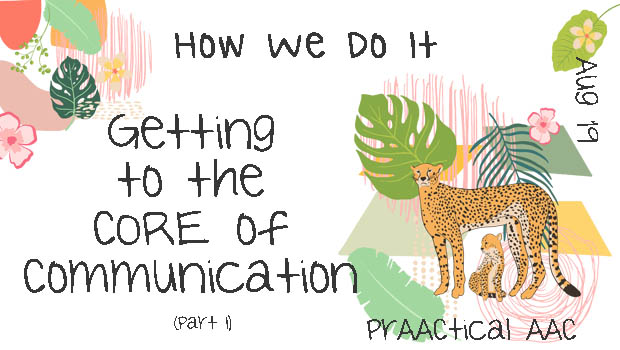
Looking to create a sustainable AAC program in your school? Today, we learn about the way one school district in Illinois created a core 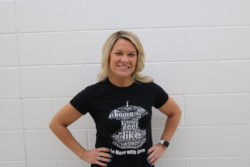 vocabulary initiative that has been up and running for almost a decade. Kelly Key, the Assistive Technology (AT) Coordinator for Barrington School District 220 serves as our tour guide. Kelly is passionate about giving students a voice through core vocabulary and empowering others to support students. She has been in the field for over 22 years as a special education teacher, an administrator, and AT Coordinator. Kelly presents at local, state, and national conferences and colleges on various AT topics including core vocabulary and AAC implementation.
vocabulary initiative that has been up and running for almost a decade. Kelly Key, the Assistive Technology (AT) Coordinator for Barrington School District 220 serves as our tour guide. Kelly is passionate about giving students a voice through core vocabulary and empowering others to support students. She has been in the field for over 22 years as a special education teacher, an administrator, and AT Coordinator. Kelly presents at local, state, and national conferences and colleges on various AT topics including core vocabulary and AAC implementation.
:::::::::::::::::::::::::::::::::::::::::::::::::::::::::::::::::::::::::::::::::::::::
How We Do It: Getting to the CORE of Communication (Part 1)
Rolling Out a Core Vocabulary Initiative- How this District has been going strong for a decade!
The Importance of Using Core Vocabulary
As we all know, individuals with complex communication needs must have access to core vocabulary words. In order to maximize our student’s exposure to core vocabulary (both verbally and visually) and because we knew the importance of immersing our students lives with these words, we launched our district-wide core vocabulary initiative 10 years ago!
Overview of Barrington 220’s Universal Core Approach to Language and Literacy
Over nine years ago our unit school district (ages 3-21) started our core vocabulary initiative. We now call it our Universal Core Approach to Language and Literacy. Our original intention with implementing the initiative was to increase the confidence and comfort level, for both staff and parents with supporting our students that use communication devices, After just six months of implementing the initiative we realized the approach was even more powerful than we expected! We have found this not only helps support our AAC users but many students that struggle with language and literacy. The following are the key components to our core approach’s success:
We use core vocabulary words based on research on language and literacy from toddlers through adults (i.e., PRC’s 100 Frequently Used Core Words, Gail Vantatenhove’s Hybrid list based off of Banajee’s research, as well as DLM’s First 40).
We use Minspeak symbols as our anchor set of symbols when a symbol is needed to represent a core word. We have two low tech core board options. 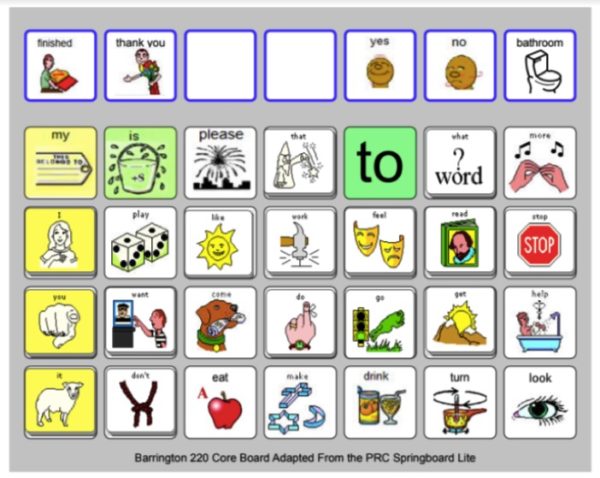
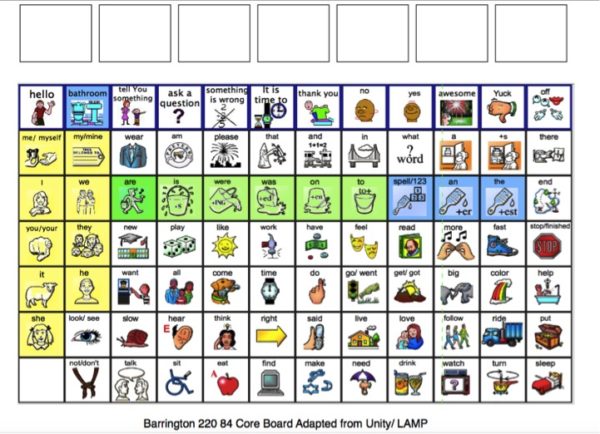 We have the 28 board that is based on the PRC Springboard 32 and the 84 board that has been adapted from the LAMP Words for Life main page. We customize student’s boards with personal fringe vocabulary.
We have the 28 board that is based on the PRC Springboard 32 and the 84 board that has been adapted from the LAMP Words for Life main page. We customize student’s boards with personal fringe vocabulary.
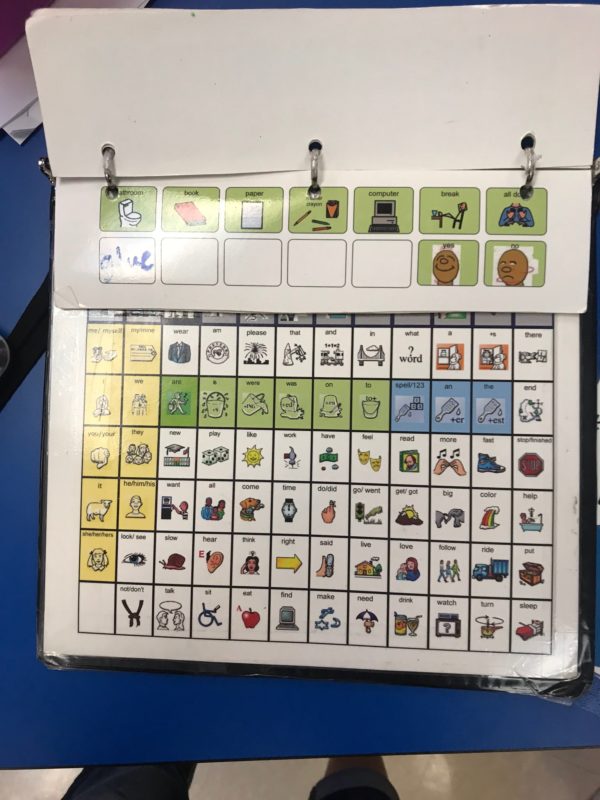
We think in core when developing lessons and activities. Our motto is “When in doubt core it out!” These words and visuals are built into lessons and activities both in school and in our student’s homes. And we think in core when engineering our visuals and supports.
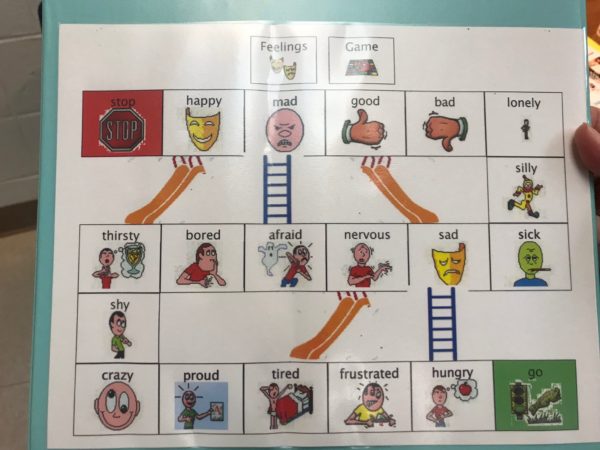
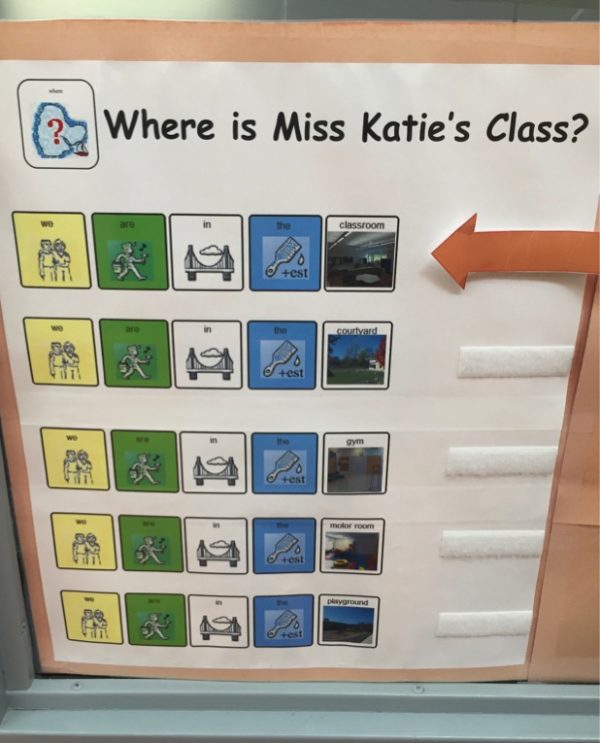
When our students enter our district at age three (or move into the district), they are exposed to core vocabulary on day one. We model on the boards and devices as much as we can. We say we talk to the students visually and verbally.

We have a multi-media Power Words core curriculum created by our very own Deidre Dobbels, (M.S. CCC-SLP/L) for our Early Childhood students which targets 16 early developing core words. We are currently working on the curriculums for our Elementary, Middle, and High School students. See the reference below to find these resources on Teachers Pay Teachers. 

We make sure all staff know what the target words are by providing visuals for the staff and students.
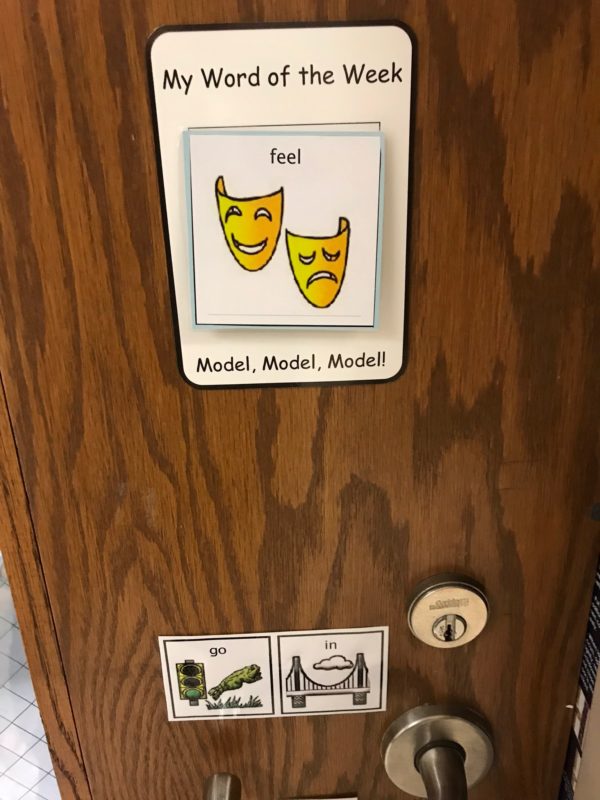
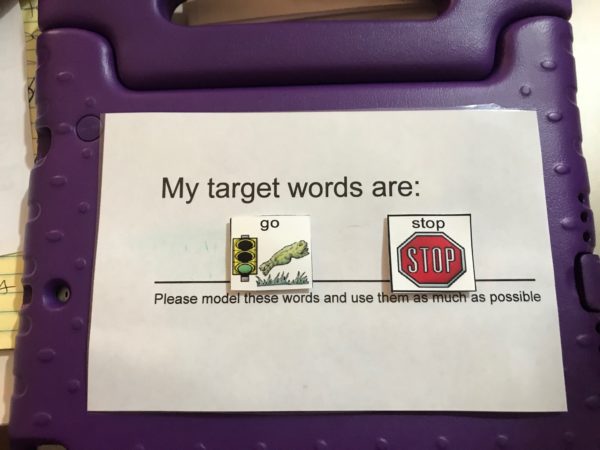
We have a core vocabulary committee. This is a group of staff from across the district meet in person and virtually throughout the year. Our meetings always start with each person bringing a lesson or activity they have “cored out” to share. We then share the file via our Core Google site. During the meetings, we also brainstorm new ideas to help implement core. We also develop and provide professional development for staff, students and parents.
We really value sharing resources in our district. We created a shared Google site where staff can add materials they have created or adapted that are “cored out.” This site also includes our interactive core boards, core images, our low tech boards, cored out visual supports, and more to download and use with students. The site is organized in folders, there is a folder for each of our core words.
As the Assistive Technology Coordinator for the entire district, I provide as much exposure and training as I can for staff, students, parents, and siblings! I do this in the classrooms through lessons I provide to the class.
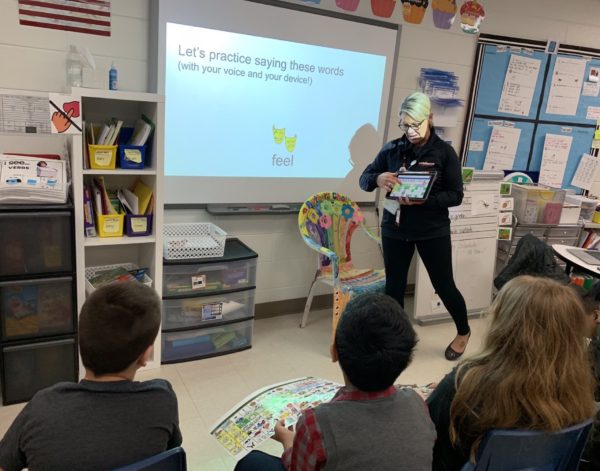
I also provide trainings for parents during the day and in the evening to include our yearly “AAC Family Fun Night”. This event has been a huge success each year. The families come with their child that uses AAC. We start the evening with tips for implementation at home and then have stations for families to go to practice using the devices and get comfortable with the language. The families then get to take the materials and games home to use. I also provide training to all new staff during new educator orientation each Fall. I have also had principals get rotating subs to cover school day trainings. Summer trainings and before and after school trainings have also been a huge success. I have been very fortunate that many of our principals have allowed me to run a series of professional development during their staff meetings as well (to special education and general education staff)!
When our students need something more high tech or more individualized, we hold a SETT meeting (We follow Joy Zabala’s SETT process where we talk about the Student (likes, motivators, access/ motor needs, vision, behaviors, etc), Environment (since communication impacts all environments, we talk about what supports have been used in the past and current supports and pros and cons of each), Tasks (we share what do you want the student to be able to communicate that they are not able to communicate. We also brainstorm specific vocabulary and phrases and intentions), Tools (for tools, we feature match, we talk about what features we would like to see on an AAC system for the student). This is a meeting with the team and parents, and at times the student as well! This is a terrific opportunity to brainstorm ideas from the start as a group and make the decision of which tool to try first together. This helps tremendously with device buy-in (see photo 10 of our form). Stay tuned for future posts in this series for more than 10 different ways that we have incorporated core vocabulary into our student’s lives and communication systems.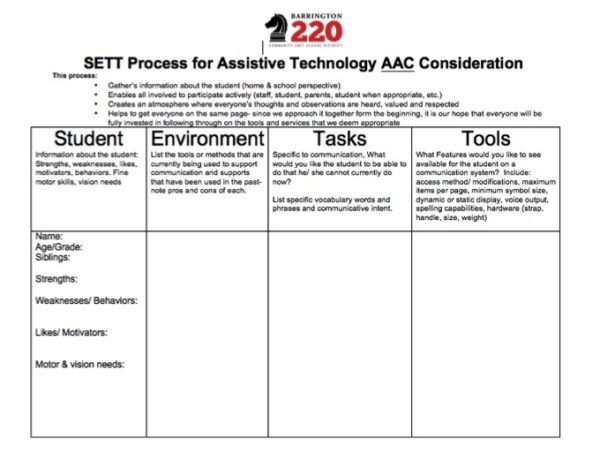
Since the implementation of our core initiative we have seen;
- Staff, students, and parents comfort level and confidence in using core words and devices increase.
- Related services staff and classified staff feel empowered and more comfortable with AAC.
- Core vocabulary words and visuals are embedded into the curriculum and daily routine.
- Although students may be using different modes to communicate, they all have similar vocabulary.
- Staff and parents are modeling on the boards and devices throughout the day.
- The focus has shifted away from the board or device and more on language and literacy.
- There is an excitement for sharing resources.
- Most importantly, students are communicating!
Tips for Rolling out Your Own Initiative:
- Make it a school, program or district-wide initiative (once you call it an initiative, it’s just what you do!).
- Get your administration knowledgeable and on board with the initiative.
- Determine your anchor symbol set when using a visual to represent a core word.
- Create (or adopt) a low tech board(s).
- Teach staff the value of modeling on the boards and devices.
- Embed core words and visuals in your curriculum materials and visual supports.
- Talk in core. Be conscious of the words you are saying and how you are asking questions to provide core words (i.e., use Gail Vantatenhove’s descriptive teaching method).
- Provide resources for staff and parents to easily access cored out visuals and resources.
- Training! Training! Training! Provide as much training as you can on partner skills to staff, students, siblings and parents!
- Hold a SETT meeting for individualized/ customized supports.
Keep a lookout for our next Blog Post where Deidre Dobbels and I share our top ways we have personalized core-based communication for individual students.
::::::::::::::::::::::::::::::::::::::::::::::::::::::::::::::::::::::::::
References/Credits
- Gail Vantatenhove
- Gail Vantatenhove’s Hybrid list based off of Banajee’s research
- Project Core – Universal Core, University of North Carolina Chapel Hill
- Joy Zabala – SETT Framework
- PRC core boards based off of PRC devices, Minspeak symbols (Semantic Compaction), & LAMP Words for Life
- PRC’s 100 Frequently Used Core Words (AAC Language Lab)
- Dynamic Learning Maps (DLM) First 40
- Powerful Words Curriculum Material can be found on Deidre Dobbles’s- TPT site
Examples show materials created by Deidre Dobbles (SLP), Jennifer Simonaitis (SLP), Katie Johnson (teacher), Alyssia Van Duch (teacher), and Kelly Key. Feel free to contact me! Kkey@barrington220.org
Filed under: Featured Posts, PrAACtical Thinking
Tagged With: core vocabulary, How I Do It, schools
This post was written by Carole Zangari

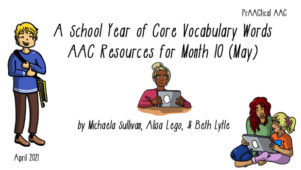
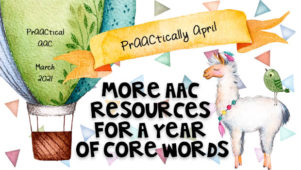
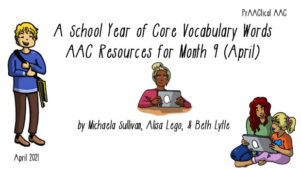
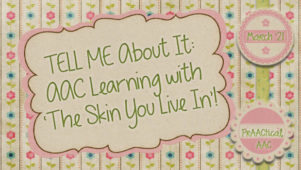
2 Comments
Wow, GREAT visuals. I love all your idea -, especially for family training. I too use Minspeak icons to represent core with my clients. Keep up this amazing work!
Thank you! Feel free to contact me! I would love to connect and share resources and ideas!